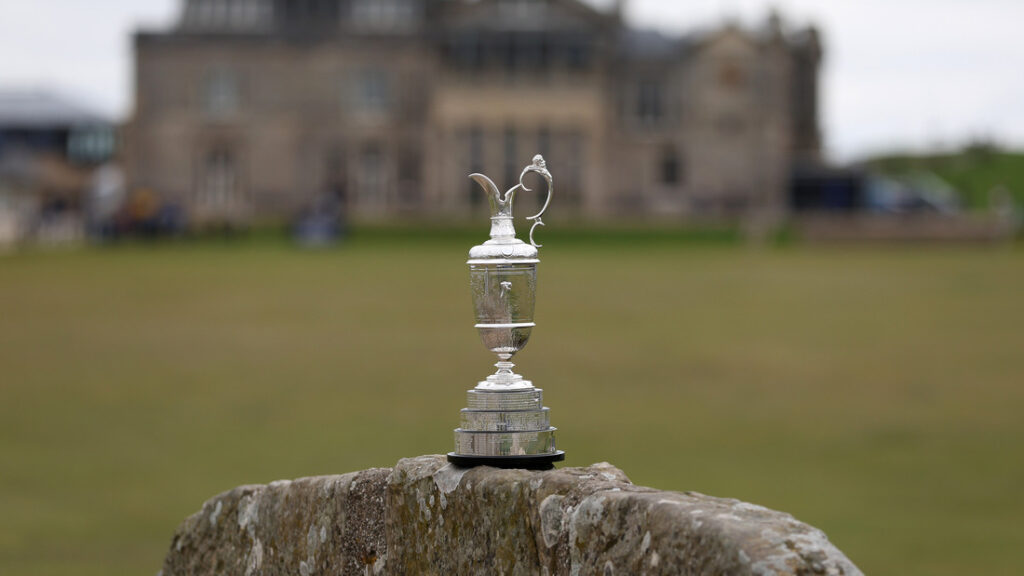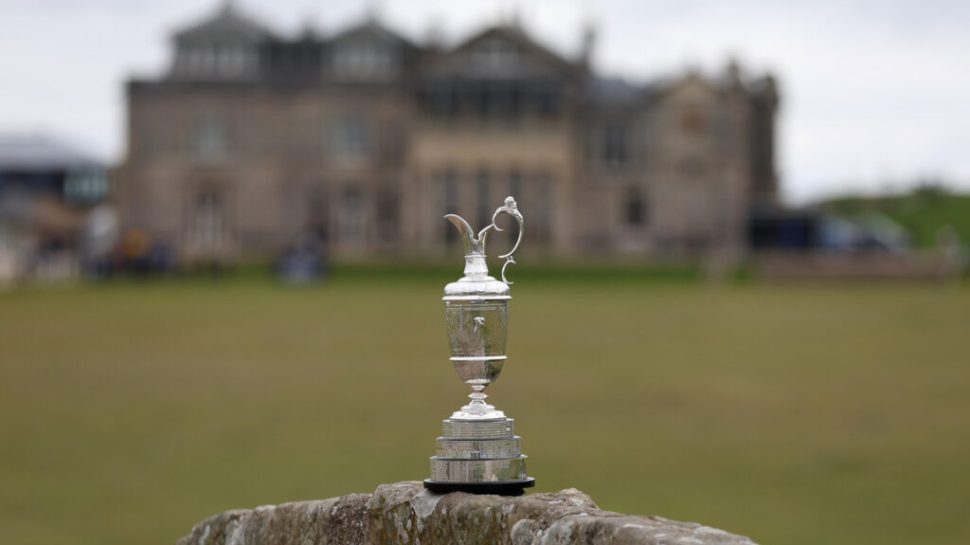
Estimated reading time: 16 minutes
Part 1
Are wind and firmness the two primary ingredients that keep links golf meaningful for elite players?
URBINA: Wind and the firm brown grass are the keys to links golf. The golfer can never rest until the ball comes to a standstill — very few American courses can give you that. The most fun watching golf comes on a links course, watching a ball flying through the air is somewhat predictable, watching a golf ball run on the ground on a links course is like riding a roller coaster full of ups and downs with banks and curves all over the place, until the ball comes to a rest, it keeps you holding your breath.
A windy day on the links requires thought and skill to navigate the bunkers, every one of them is in play, even the ones 10 and 20 yards short of the green. Keep the ball down, many a caddie on the links will say.
JOHNSON: Beyond execution, wind and firmness magnify the influence of the ground contours, so that a 3-4 foot mound close to the pin influences all the way back to the tee. Subtle changes in direction — and the buildings — make judging the wind that bit trickier at the Old Course.
GRAUBALLE: Wind and firmness plays a big part of the experience when playing a course like The Old Course, but the contours of linksland also plays a big part of it. The undulations of the ground really come into play when it is firm and players not only have to control the carry of the ball, but also the roll and doing this in windy conditions is definitely not easy. However, this is also what makes links fun – not only for the elite players, but for all players.
STRAKA: I think so. There are others, but I tend to agree those are the two ‘primary ingredients’.
LOBB: Wind probably more so than firmness in my opinion because of the spin that can be generated by the balls. When you get wind and firmness then the challenge is suitable for these elite golfers.
DOAK: Yes, wind and firm conditions reward the golfer who can shape his shots to counteract their influence.
CLAYTON: Bunkers too because they are usually a one shot penalty and to be avoided at all costs. At the recent US Open they were havens from the long grass surrounding them. At Brookline players were hoping to be in the bunkers. At The Old Course they will do anything to avoid them.
What hole captivates you the most at The Old Course and why?
DOAK: The 11th is my idea of an ideal par-3 hole, but holes like the 2nd and 4th are very underrated because of the influence of the contours at the front of those greens.
JOHNSON: Every one. I’d pick the 14th – there isn’t a par-5 anywhere else that provides interest over its every square yard, and that all works back from a great, topographically bold green complex.
LOBB: Well it has the be the 17th as it is the total potential disaster hole. I can’t imagine any leading player coming up this hole thinking they have won the Championship from the fairway. It is only after putting out that some calmness might be restored.
CLAYTON: It’s hard not to go anywhere else but the 17th. It’s an amazing greens complex – one you could never build today and not be heavily criticised – and it’s proved capable of posing a multitude of vexing questions over centuries. Half-par holes well done are the best holes in golf.
URBINA: The 14th hole on the Old Course captivates me the most. Rarely can you say a par-5 hole holds that much interest. Called “Long”, the 14th, requires your attention on every shot. The Beardies, Elysian Fields, Hell Bunker and, of course, a few of the pot bunkers close to the green that restrict a full swing. No guarantees for a sand save when you get aggressive on the second shot trying to get to the green. There’s also a very undulating green making an eagle very rare. Oh, how I wish I could design every par-5 with such intrigue.
STRAKA: The 17th — the Road Hole. I like the strategy. I also like that it brings physical architecture into play which is so unlike any other hole. You couldn’t do that in most countries due to liability alone.
It’s also the site of the best bogey I ever made in my life, lol. I hit it onto the hotel roof, hit a provisional which I ended up having to play in front of a client, knocked it on with a 5 iron and holed the putt for a 5. Like I said, the best bogey I ever made!
GRAUBALLE: The Road Hole — the 17th. It is iconic and it is the penultimate hole and it forces the players to make choices. It is a strategic/heroic challenge that still challenges the players and we have seen dramatic outcomes.
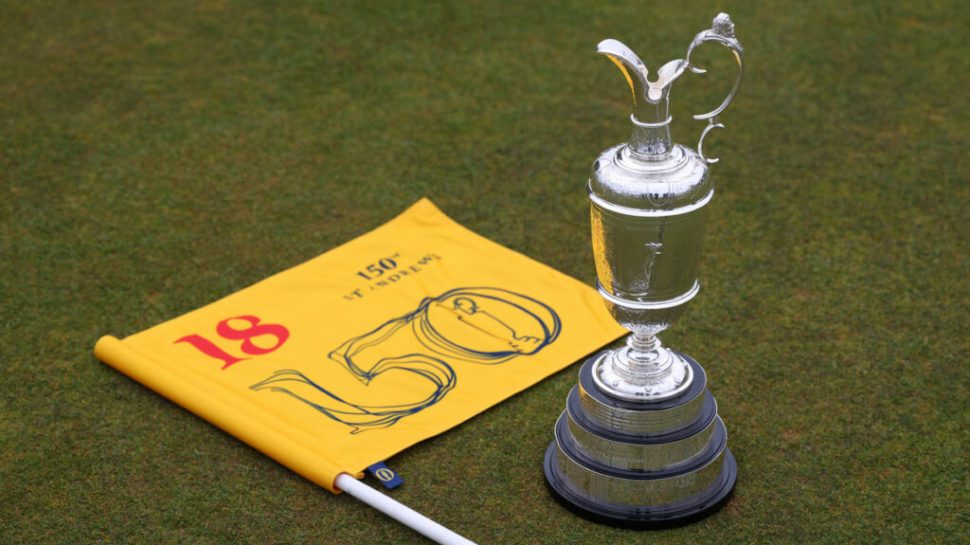
Which one the least and what would you do to improve it?
STRAKA: I draw or hook the ball, and I’m righty, so the 1st hole doesn’t bother me, but average players could probably use a little more berth down the right side. I don’t think that’s going to happen any time soon though.
DOAK: That’s like asking which book of the Bible should be rewritten. Anyone who proposes changing anything on The Old Course should captain the first flight to Mars.
URBINA: The 8th hole, “Short”, is one of the holes that does not excite me. The Old Course has only two par-3 holes and compared to the 11th hole, the “Eden” — it seems like somewhat of a resting hole. But no need to spice it up — the 8th hole gives you that chance to have a little fun in your round of golf.
GRAUBALLE: Don’t really know, probably the 2nd, but I would not want to change it. I think the course has stood the test of time and one should honour this as much as possible. Of course, the course has been improved upon over the years and in response to the changes in equipment and players’ abilities, but I think any change should be very subtle and probably unnoticeable for most people.
CLAYTON: Probably the 9th. By Sunday they have used up the most interesting parts of the green and seemingly resort to cutting it right in the middle of one of the few single greens on the course. It is what it is though and I wouldn’t dare do anything to improve it.
As Alister MacKenzie said alterations don’t always equate to improvements.
JOHNSON: The Old Course should be preserved in time. Of the changes prior to the 2015 Open, I would most like to ‘undo’ the two pots short-right of the 2nd green – to restore the uncomplicated contrast between the open, flat right and lumpy higher left.
LOBB: Some may say the 9th and 10th are boring or flat holes. It is true that they are flat but boring I say no. The expectation of birdie or eagle is prominent and adds to the pressure on these somewhat ‘easy holes’.
What letter grade would you give to the R&A for the way it prepares the various links courses that annually host the game’s oldest major championship?
LOBB: A+ with modern thinking but respecting the traditions of the championships over the past 150 years.
JOHNSON: I’d like to see less rough on the Old Course – especially to the left of the 16th and 17th, where it prevents a shot from chasing away into a worse position. Otherwise, The R & A run a great championship that is a pleasure to attend.
STRAKA: A.
CLAYTON: I played in 9 Opens. 8 were an A+. Turnberry in 1986 with all the thick rough and narrowed fairways was a B-. Likewise Carnoustie in 1999. But they were aberrations – things you need every now and then to get back on track. Obviously I didn’t see Muirfield in 1966 but from all accounts it was very narrow and ‘narrow’ rarely makes for the best seaside golf.
DOAK: In general, the R & A do a great job of providing appropriate conditions for a championship. Their only hiccups in recent years were at St. Andrews, having the greens a little too fast and then having to suspend play because the wind made balls move on the greens.
GRAUBALLE: A – the care and preparation for the Championship is outstanding. With every aspect thought of from the carbon footprint to the ecology of the sites they make every effort to make it sustainable.
URBINA: A. I would give them an A+ if they explored all of the edges of the greens with pinning locations, but in competition I am not sure the pros would think that was much fun.
What links course would you like to see The Open conducted at that has never done so irrespective of the logistical issues?
GRAUBALLE: I think Royal County Down would be a great venue – a spectacular course. Or perhaps one of the newer links courses could be an interesting option as there are certainly some great new links courses which could be used and introduce some new blood to the rota.
URBINA: North Berrick, Prestwick, Royal Dornoch. Throw away the idea of the total score. Where the average score over four days for the winner on major courses today is between 265 and 275. I say so what, if the final round scores were anywhere between 255 – 265, who cares? The best golfer won no matter the score. We could begin to have major competitions on shorter courses and break down that barrier that longer course — 8,000 yards plus — are better.
JOHNSON: Prestwick – it would make great entertainment to see the pros handle the many “what the heck” moments!
LOBB: Whilst these courses would never host a championship I would love to see the Open at St Enodoc – I love the course. Another interesting one would be Royal Cinque Ports as it builds in the drama and has a very tough back nine – lots of potential banana skins.
CLAYTON: Dornoch is the obvious Scottish one. Pity it’s so far north but its promise is the effort it takes you to get there is worth it. Royal Cinque Ports is next on the list of English courses. Royal County Down in Ireland – what a beautiful course it is.
DOAK: I’d love to see them return to the original home of the Open at Prestwick.
STRAKA: I’ll give you two for very different reasons. Royal Porthcawl, because Wales deserves to get an Open Championship, being the only country in the U.K. never to have hosted.
The second is North Berwick, West Links. I’d love to see how the world’s best players navigated around all the fun and quirk of the golf course. Oh, and I think going back to Prestwick would be super cool too.
In ascending order, the top five links courses that regularly host The Open are what and a quick reasoning on why?
DOAK: In asending order–Carnoustie, the toughest test; Royal Portrush, the new kid on the block; Royal St. George’s, the most beautiful and most challenging visually; Muirfield, the best bunkered course anywhere: And at the top — The Old Course at St. Andrews.
STRAKA: Troon, Turnberry, Portrush, Muirfield, St. Andrews. Simply, because they’re my favorite to play.
LOBB: The Old Course – the tradition, atmosphere. Royal Birkdale – Fantastic course, great spectating. Turnberry – Not on the current rota but enjoyed some wonderful previous experiences. A course just getting better. Portrush – Spectacular course and rugged landscape. Royal St Georges – Bold landscape and true test for the elite.
GRAUBALLE: They are all great courses, but personally I have two favorites: The Old Course – tradition, history, home of golf. Royal Birkdale – great playing challenge and a great venue for spectators and I was lucky enough to be involved in the preparation for The Open in 2008.
URBINA: I would prefer not to rank links courses. Each can stand on their own merit, but for me St. Andrews stands alone at the top. After that, Turnberry, Portrush, Muirfield , Carnoustie, Troon. They are all fine links course and I have enjoyed them all, but playing away from town and then playing back into town on the Old Course is an experience you won’t soon forget. And it’s public!
CLAYTON: In ascending order — Royal Portrush. Odd to pick a course I’ve never seen in person but everyone says it’s the equal of Royal County Down and that’s good enough for me. Then Carnoustie. With little of the charm at St. Andrews but the hardest four finishing holes on the rota and a ruthless exposer of a weakness in your game.
Then Royal St. George’s — everything the “fair” crowd doesn’t like because it’s wild and unpredictable. Things guarantee to make golf interesting. In the number two slot – Muirfield. Brilliant golf course and always a great Open. In the top spot — the Old Course. The best back nine in golf and the besst town for the world of golf to congregate.
JOHNSON: In ascending order – Royal Portrush – elegance and adventure. Carnoustie – the ultimate test! Royal St. George’s – brawny, bold, and grand. Muirfield – the most architecturally polished of any links course. At the top — the Old Course at St Andrews — best course in the world.
***
The Participants
Caspar Grauballe
Principal / Golf Course Architecture by Caspar
Rungsted Kyst, Denmark

Started his career with Hawtree Ltd working primarily on existing links courses like Lahinch and Ballybunion. Lead architect on Trump Scotland in Aberdeen. His own company started in 2012 and has recently opened a new course in Poland — Black Water Links and is busy in France and Scandinavia with upgrades of several existing courses.
Caspar is serving as Vice President of the European Institute of Golf Course Architects.
Mike Clayton
CDP
London, United Kingdom

After a very successful amateur career which included victory in the 1978 Australian Amateur and the 1977 and 1981 Victorian Amateurs, Mike Clayton turned professional in 1981 and played on the Australasian Tour from 1981-2004 winning seven times. He was also a regular participant on the European Tour from 1982 to 1996.
Having studied golf architecture whilst travelling the world as a touring pro, he formed Michael Clayton Golf Design in 1995 in partnership with John Sloan and the late Bruce Grant. In 2010, that business morphed into Ogilvy Clayton, which later became OCCM In 2019 — he founded CDP with architects Mike DeVries and Frank Pont.
Tim Lobb
Golf Course Architect – Lobb & Partners
President – EIGCA
Woking, United Kingdom

Australian born and UK resident for past 24 years, EIGCA President Tim Lobb comes with a vast experience of designing both new build projects and a collection of a diverse mix of renovation and restoration projects in the UK and beyond. Of particular interest to Tim is designing courses that sit softly and harmoniously in their individual environments. No two projects are the same.
Tim has designed in more than 25 countries, on more than 50 projects and has 26 years of overall experience. He is the Founder and Principal of Lobb + Partners, based in Woking Surrey, UK with an additional office in British Columbia, Canada.
Clyde Johnson
Principal, Cunnin Golf Design
St. Andrews, Scotland
The ideal golf course architect must ‘have the soul of an artist, the brain of an engineer and the heart of a golfer’ – American golf writer Herbert Warren Wind’s infamous quote in the back of my mind, I headed off to the University of Sheffield to read Structural Engineering and Architecture. Promoting collaboration between creative and technical disciplines, this study introduced the daily challenges that face a field-based golf course architect whom tries to balance the call for inventive play and aesthetic interest with environmental and economical sensibility.
Since establishing Cunnin’ Golf Design in 2015, I have continued to assist Tom Doak and Renaissance Golf Design on select projects while building a client-base of architecturally significant courses. I look forward to working with clubs and clients that love the game of golf and its playing fields as much as I do.
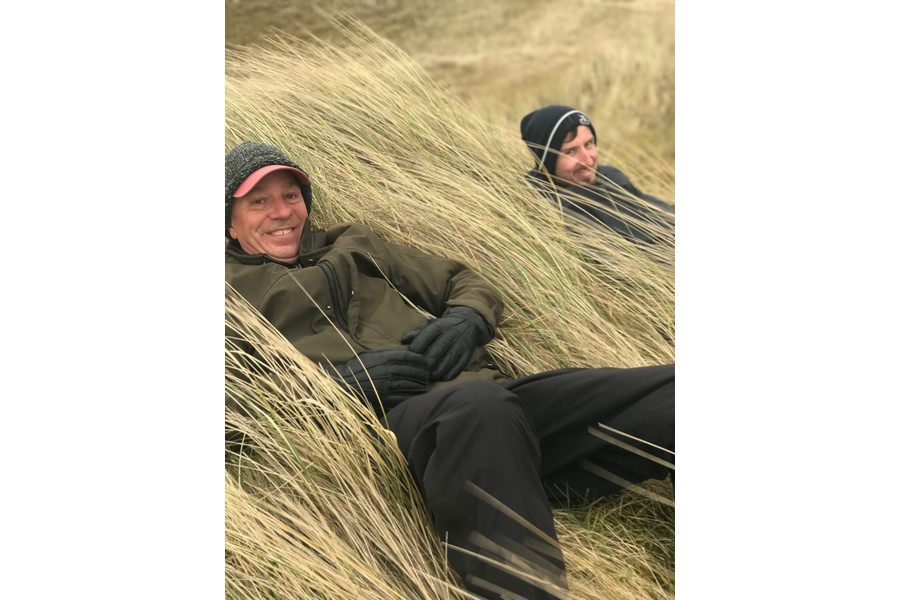
Tom Doak
Renaissance Design
Traverse City, Michigan
Thanks to a scholarship from Cornell University, Doak got to live on the links — caddying at St. Andrews the summer after his graduation, then spending the next seven months playing and studying every golf course of note.
In that year abroad, he discovered a challenging, natural outdoor sport played by all ages, on exciting courses which had cost nothing to build and which were affordable for all to play. Ever since, he has felt a responsibility to build courses reflecting the ideals of the game as the Scots still play it. His ideas on golf course design are shaped by having seen nearly every great course in the world — more than 1,000 in all.
Doak’s first solo design opportunity came at the age of 26, and he has not looked back. Major fan of both Alister MacKenzie and Pete Dye. Today, his design commissions have given him the chance to lead by example — excited in getting the opportunity to show what he has learned.
Jim Urbina
Principal, Jim Urbina Golf Design
Littleton, Colorado
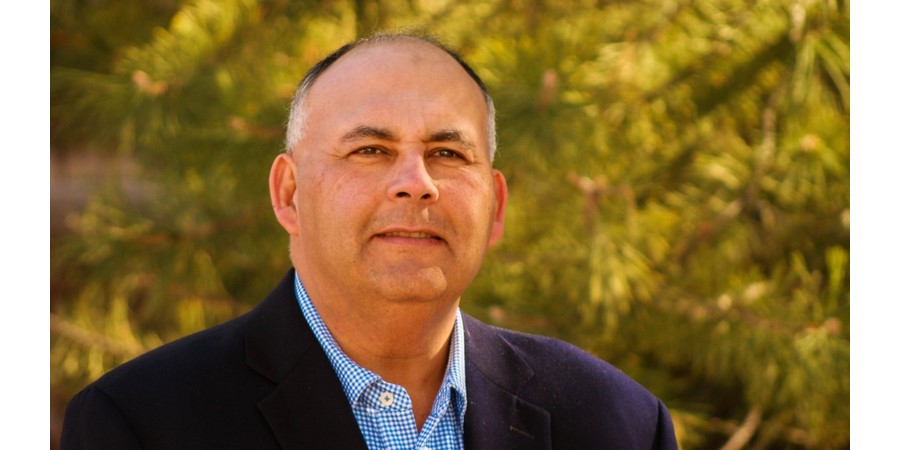
Began his career working for the iconic golf course designer Pete Dye. Went on to work for Pete and his son Perry on many golf courses in the U. S. and the Asian Rim. It was his association with the Dye family that allowed him to experience the beauty and charm of the links lands of Scotland and Ireland. The Dyes sent Jim to study what the links of the U.K. had to offer back in the middle 80s when traveling to places like St. Andrews and Prestwick were not that fashionable.
He went on to design and build many highly regarded modern courses and has restored many of the top 100 golf courses in the U.S. including the works of Alister Mackenzie, C.B Macdonald, Seth Raynor, Donald Ross, A.W. Tillinghast and many other Golden Age designs. In 2022 working on restoring the only Mackenzie designed course in Canada as well as several other Raynor and Ross courses.
In 2023 he will be working on restoring P.B. and Pete Dye’s Loblolly Golf Club as well as restoring Pasatiempo where he has spent over 20 years protecting the sanctity of Alister Mackenzie’s design in Santa Cruz, California. He has several New and Golden Age designs restorations projects on the drawing board.
Jason Straka
ASGCA
Fry/Straka Global Golf Course Design
Naples, Florida
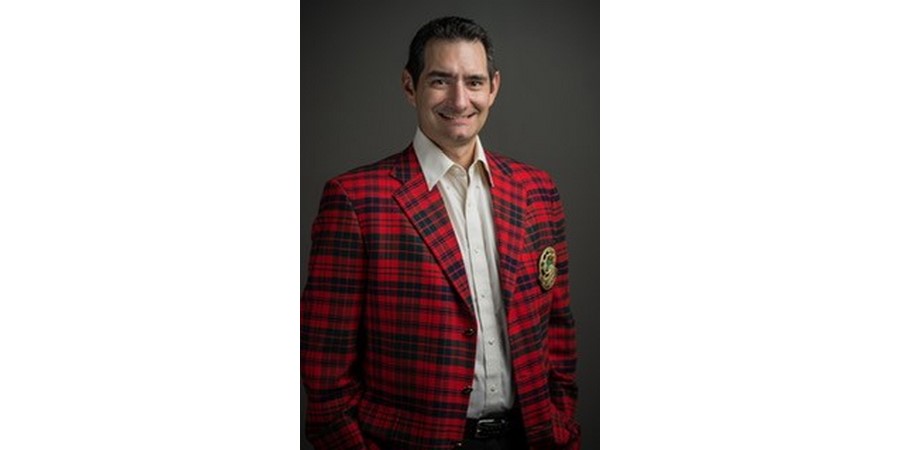
Jason is business partners with Dana Fry and together they operate a worldwide golf design business. Jason is the current President of the American Society of Golf Course Architects (ASGCA). Recent projects of Fry/Straka include Union League National Golf Club, Belleair Country Club, and the Desert Course at Cabo Del Sol.
